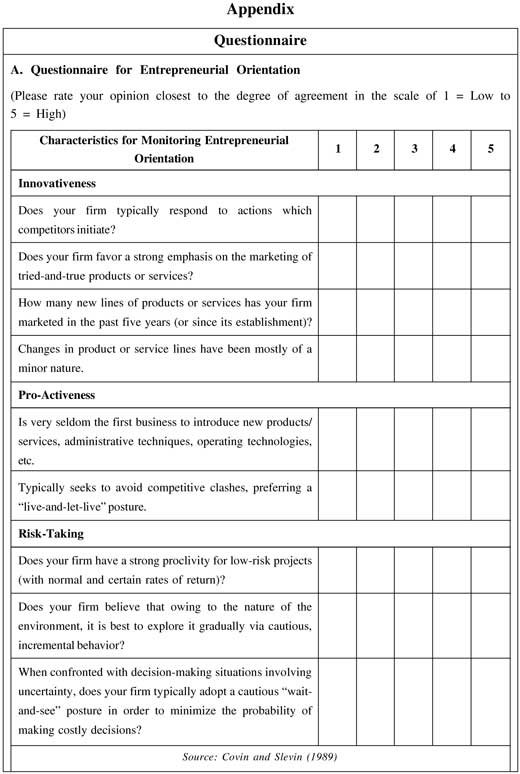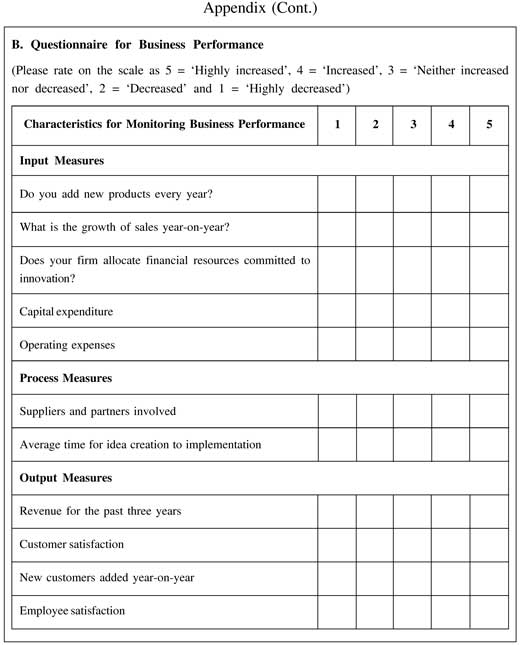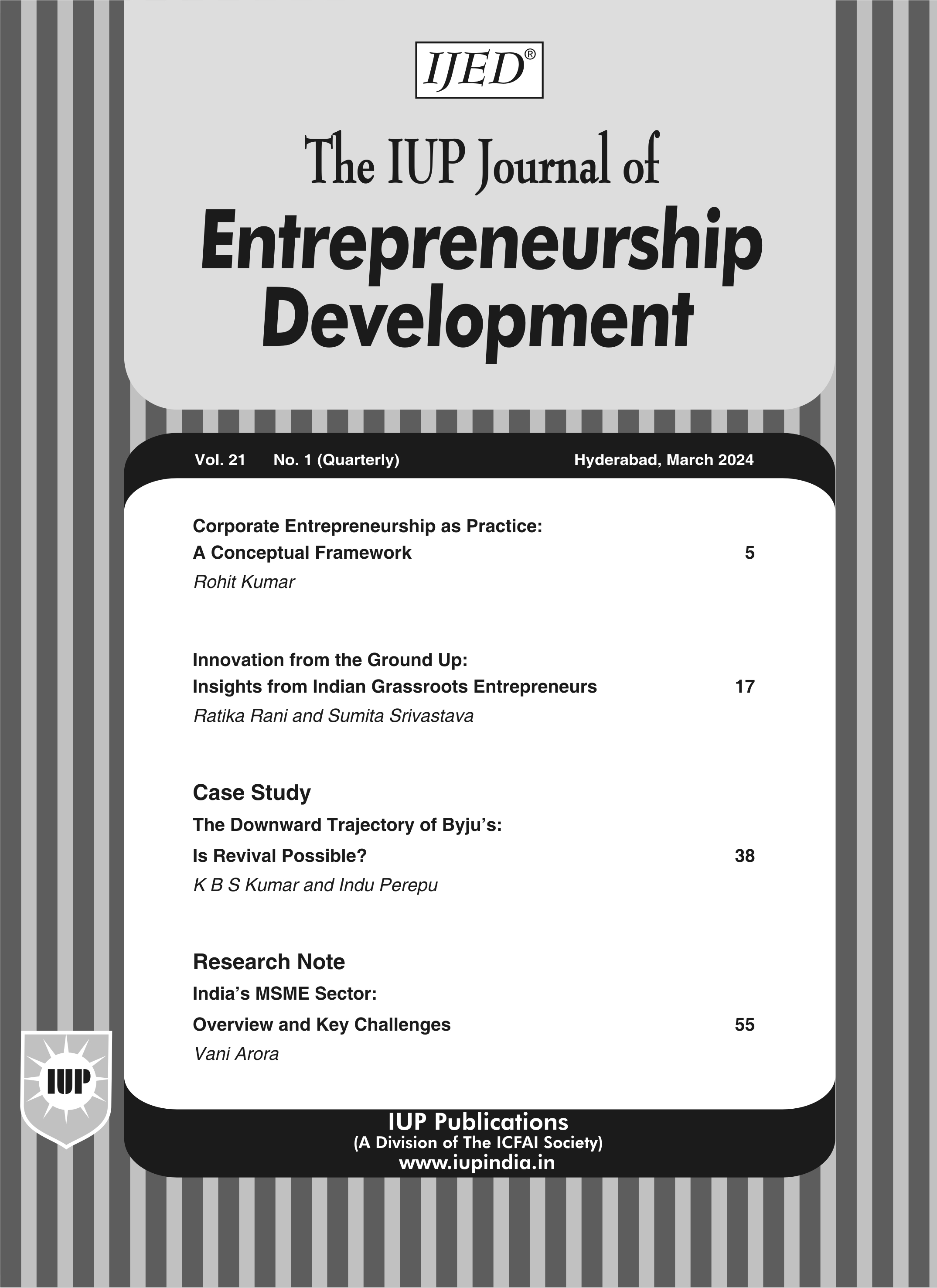
Sep'18
The IUP Journal of Entrepreneurship Development
Archives
Entrepreneurial Orientation and Business Performance with Special Reference to SMEs in Kurunegala District of Sri Lanka
Deepal N Perera
Management Consultant,
236E "Dilani", Kirindiwita Road,
Ganemulla, Sri Lanka, and Ph.D. Scholar,
ICFAI University Tripura, Agartala, India;
and is the corresponding author.
E-mail: deepal@expack.lk
P Venkateswarlu
Dean, IBS Business School,
#65 Nagarjuna Hills, Panjagutta,
Hyderabad 500 082, Telangana, India.
E-mail: venkat@ibsindia.org
Entrepreneurial orientation is, in many instances, mentioned as an imperative ingredient of growth, competitive advantage and superior performance. This paper investigates the relationship between entrepreneurial orientation and business performance of Small and Medium-sized Enterprises (SMEs) in Sri Lanka. A questionnaire measuring entrepreneurial orientation and business performance was distributed among the owners/managers of SMEs of Kurunegala district in Sri Lanka. The findings reveal a significant positive relationship between entrepreneurial orientation and business performance of SMEs. Thus, it is inferred that entrepreneurial orientation is very important for the survival of SMEs in Kurunegala district in Sri Lanka.
Introduction
Entrepreneurship is the life blood of any economy. Effective and successful entrepreneurs have always emerged through small and medium enterprises. Hence, entrepreneurship has become the vital ingredient of economic development at any level.
There is no doubt that entrepreneurship plays a major role in Sri Lanka's economic development too. But entrepreneurs in Sri Lanka are facing greater challenge in the modern business environment under tough competition, rapidly changing technologies and globalization of products and services.
Two of the world's largest economies India and China have gained their current level of economic growth and also contributed to the global economic growth due to the effective contributions made by Small and Medium-sized Enterprises (SMEs). Well over 500 blue chip organizations in India had started their business as small entrepreneurs. Even though a tiny island, Sri Lanka owes its economic growth to hundreds and thousands of small-scale entrepreneurs.
Being a developing country, still a large population (about 60%) is living in rural areas of Sri Lanka, which has about 23.5 million population. Many rural-based small and medium industries play a major role in creating a favorable economic scenario, in which many large entities flourish and boom and contribute back to exports revenue. Hence, it is of paramount importance that these rural-based SMEs are motivated and encouraged to contribute to the economic development and win its share of advantage.
In reducing unemployment, inequality of wealth distribution, poverty eradication and mitigation as well as contributing to sustainable economic growth, SMEs have been recognized as an important strategic sector always. Despite many local, regional and global challengers, since independence in 1948, successive governments have initiated to diverse programs to facilitate growth and development of SMEs in their potential areas and sectors of the national economy.
Entrepreneurial orientation is an individual attitude and perception towards involving in entrepreneurial task, be it within the scope of current firm or even creating a new enterprise. There are occasions that this attitude and perception could become either positive or negative.
Against this background, the present paper attempts to find out whether there is a significant relationship between entrepreneurial orientation and business performance of SMEs in the strategically important Kurunegala district of Northwestern Province of Sri Lanka.
Literature Review
The way an entrepreneur accepts the system, methods, practices and decision-making styles to engage entrepreneurially can be referred to as a firm's entrepreneurial orientation within the activities of entrepreneurship. According to Mintzberg (1973), there are similarities of how a manager in a large corporation would act. Entrepreneurial orientation is the combination of the main attributes such as the entrepreneurial disposition to autonomy, encouraging experimentation (innovativeness), risk-taking ability, initiatives (proactiveness) and ability to aggressively compete within the market place.
The definition of innovativeness is explained as the firm's propensity to involve in new idea generation, experimentation, and research and development activities. This may cover the growth of products and services and novel administration tactics and technologies for fulfilling organizational functions and objectives as jointly advocated by Ginsberg and Venkatraman (1985), Morris and Paul (1987), Covin and Slevin (1989), Lumpkin and Dess (1996), and later advanced by Schumpeter (1993 and 1994).
In the context of academics, the degree to which an enterprise is entrepreneurial is widely regarded as its 'entrepreneurial orientation'; the most commonly utilized definition of entrepreneurial orientation is based on performance by Miller (1983), further expanded by Covin and Slevin (1989) and Lumkin and Dess (1996). This conceptualization has been used in well over 225 studies concentrating not only on entrepreneurship but also covering wider areas of management, marketing and healthcare.
Management literature on entrepreneurship orientation differs in the way different researchers advocate the elements into the entire construct of entrepreneurial orientation. The authors suggest that varying elements may reflect in varying degrees in an organization's entrepreneurial orientation. Hence, these elements should be evaluated and assessed separately to ascertain each one's influence on the overall entrepreneurial orientation construct.
The entrepreneurship success in countries like China and the US has been the main reason for the global economic development trends (Schramm, 2006). As a major contemporary trend, China has been able to emerge as one of the main 'swing factors' in global economic development (Malik, 2013).
In US, it appears that entrepreneurs in SMEs are the driving factor of the economy. The US Small Business Administration Report states that 25.8 million small businesses have generated more than 50% of private sector employment opportunities, while it also contributes to more than half of the nation's GDP. Also, entrepreneurship has been the principal source of new job creation in the US (US Census Bureau, 2006). Hence developing countries like Sri Lanka can eventually learn valuable lessons from this when it comes to entrepreneurship and its contributions to the economy.
The International Financial Corporation (IFC), in its periodic banking survey in the SME markets of Sri Lanka during 2006-07, revealed that 80-90% of the total enterprises and organizations, 20% of industry value, and 70% of employment opportunities are contributed by the rural and semi urban-based SMEs. Further a significant 42% and 53% increased contribution from the Sri Lankan SME sector had taken place in 2010 and 2011 respectively (Ministry of Finance and Planning, Sri Lanka Annual Report, 2011).
Many empirical researches have been conducted previously to ascertain whether there is a relationship between entrepreneurship or entrepreneurial orientation and firm's business performance and many have found that a positive relationship exists. Even in the Sri Lankan context, such a situation has been encountered in the Western Province (Wijetunga and Pushpakumari, 2013).
In order to improve the performance of the businesses, it is suggested that SME owners and managers should focus on the level of different strategic orientations of the organization.
The SMEs' entrepreneur orientation and business performance in Hambantota district in Sri Lanka has been examined by Fairoz et al. (2010). They revealed the fact that the degree of entrepreneurial orientation was moderate in a majority of SMEs and there was a significant relationship of reactiveness, innovativeness, risk taking and overall entrepreneurial orientation with market share and growth.
Objective
The main objective of the study is to investigate the relationship between entrepreneurial orientation and business performance of SMEs in Kurunegala district of Northwestern Province of Sri Lanka.
For the purpose of the study, the following hypothesis was tested:
-
H1: Positive relationship exists between entrepreneurship orientation and business performance.
Data and Methodology
Study Area
Kurunegala administrative district has been identified as one of the most vibrant and thriving districts of Sri Lanka (Annual Report, 2014). That is the main reason behind selecting this particular district for the study. Kurunegala is a district in the Northwestern Province of Sri Lanka consisting of total 4,476 villages (Figure 1). It is bound by five districts—in the north by Anuradhapura district, in the east by Mathale district, in the south by Gampaha and Kegalle districts and in the west by Puttlam district. Kurunegala district has 7.3% of total population of Sri Lanka. According to the census data, the estimated population of Kurunegala in the year 2020 would be 1.9 million. A majority of residents of Kurunegala district are Sinhalese. Further, Kurunegala has the highest number of small industries and the second highest number of medium enterprises (Department of Statistics and Census, 2015).
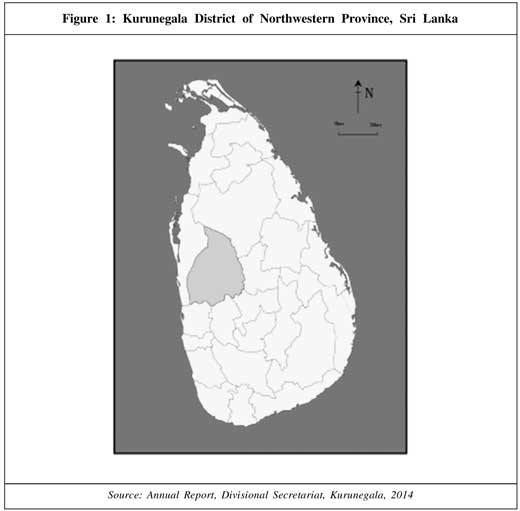
Sampling and Data Collection
The population of the study consists of manufacturing SMEs in Kurunegala district of Sri Lanka. Due to the absence of nationally accepted definition for the SMEs and the unavailability of adequate information, it is difficult to identify the exact total population of the SMEs in Sri Lanka.
The data was collected using a questionnaire (see Appendix). The questionnaire was administered by post to about 350 SMEs in Kurunegala district randomly selected from the list of registered manufacturing SMEs in Department of Census and Statistics of Sri Lanka at the end of 2011. The response was not very encouraging, as only 95 SMEs replied. Out of which, 20 were incomplete, hence they were not considered for analysis.
Variables Used in the Study
Entrepreneurial Orientation
Covin and Slevin (1989) had developed a questionnaire for measuring the entrepreneurial orientation of the firm. A part of this questionnaire has been used in the present study (see Appendix). The questionnaire comprises three components: innovativeness, proactiveness and risk-taking. The respondents are owners/managers. They are asked to respond on a five-point Likert scale regarding the extent of their firm's strategy.
Business Performance
The firm's performance is measured through a subjective approach through the perception of the owner/manager (see Appendix). They are asked to give their responses on input, process and output measures. The subjective approach is chosen because there are no suggested measures for firm performance by the researchers. Objective approach is not possible because owners/managers are not willing to disclose information pertaining to their firm. The trend of each of these indicators during the last three years is recorded as highly 'increased', 'increased', 'neither increased nor decreased', 'decreased' and 'highly decreased' using a five-point scale, following the five-point Likert scale.
Reliability test was conducted to check the consistency of the questionnaire separately for entrepreneurial orientation and business performance. The Cronbach's alpha values achieved are 0.62 for entrepreneurial orientation and 0.69 for business performance. XLSTAT package is used for data analysis.
Results and Discussion
Demography of the Sample
The profile of the respondents is given in Table 1. 71% respondents were Sinhalese, 20% were Tamils and others 19%. Among the owners/managers who were administered the questionnaire, 87% were males and 13% females. 46% of them had Diploma as their major qualification; 55% had a degree and 23% were postgraduates. 38% of respondents were less than 30 years of age and 40% were in the age group of 30-40 years. 57% of the firms were set up in the past five years and 29% in the last 10 years. Firms that have less than five
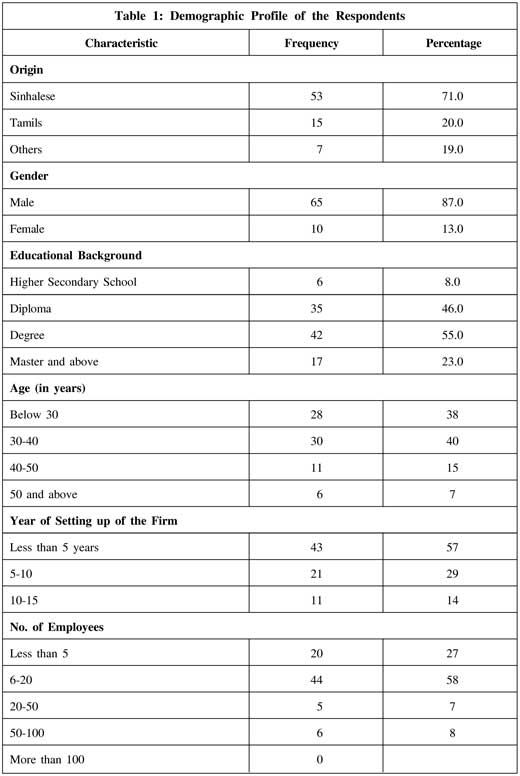
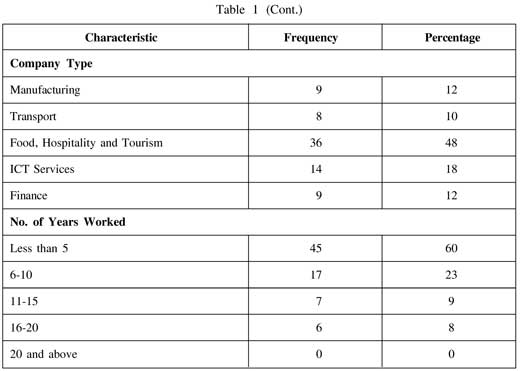
employees working in it are 27%, while 58% firms have 6-20 employees working in it. Food, hospitality and tourism industries account for 48% in Kurunegala and the remaining are ICT, manufacturing, transport and finance. 60% of the respondents have work experience of less than five years.
Testing of Hypotheses
The data analysis indicated that there is a significant positive correlation between entrepreneurial orientation and business performance (r = 0.52, p > 0.001). Regression analysis is conducted to test the relationship between these two variables with business performance as the dependent variable and entrepreneurial orientation as the independent variable. The results support the hypothesis that there is a relationship between entrepreneurial orientation and business performance (Table 2).
-
Estimated regression equation: y = 27.488 + 0.4829x
where y = Business performance, and
x = Entrepreneurial orientation

Conclusion
This study examines how entrepreneurial orientation can affect the business performance of SMEs in Kurunegala district of northwestern province of Sri Lanka. This district is most active in terms of SME-based entrepreneurship as it has both agriculture and manufacturing-based SMEs.
The study concludes that entrepreneurial orientation has a significant positive effect on business performance, which means that as the entrepreneurial orientation level increases, the degree of business performance also increases. It can also further be inferred that entrepreneurial orientation of SMEs' owners/managers of Kurunegala district in Sri Lanka influences the success and survival of the SMEs.
Bibliography
- Annual Report (2011), White Paper, National Strategy for Small and Medium Enterprise Development, Ministry of Finance and Planning, Sri Lanka.
- Annual Report (2014), Kurunegala District Secretariat.
- Cooper D R and Schindler P S (2006), Business Research Methods, 8th Edition, McGraw-Hill.
- Covin J G and Slevin D P (1989), "Strategic Management of Small Firms in Hostile and Benign Environments", Strategic Management Journal, Vol. 10, No. 1, pp. 75-87.
- Department of Statistics and Census (2015), Government of Sri Lanka, Colombo.
- Fairoz F M, Hirobumi T and Tanaka Y (2010), "Entrepreneurial Orientation and Business Performance of Small and Medium Enterprises of Hambantota District Sri Lanka", Asian Social Science, Vol. 6, No. 3, pp. 34-46, available at http://www.ccsenet.org/journal/index.php/ass/article/view/5374
- Fisher R A (1925), Statistical Methods for Research Workers, 5th Edition (Revised and Enlarged), Oliva & Boyd, London, UK.
- Ginsberg A and Venkatraman N (1985), "Contingency Perspectives of Organizational Strategy: A Critical Review of the Empirical Research", Academy of Management Review, Vol. 10, No. 3, pp. 421-434.
- Lumpkin G T and Dess G (1996), "Clarifying the Entrepreneurial Orientation Construct and Linking it to Performance Gregory Academy of Management", The Academy of Management Review, Vol. 21, No. 1, pp. 135-172.
- Malik Wricha (2013), "Entrepreneurial Orientation and Personality Characteristics", International Journal of Education and Management, Vol. 3, No. 2, pp. 272-275.
- Miller D (1983), "The Correlates of Entrepreneurship in Three Types of Firms", Manag. Sci., Vol. 29, No. 7, pp. 770-791.
- Mintzberg H (1973), The Nature of Managerial Work, Harper & Row, New York.
- Mohamad Z and Rosli M (2013), "Entrepreneurial Orientation and Business Success of Malay Entrepreneurs: Religiosity as Moderator", International Journal of Humanities and Social Science, Vol. 3, No. 10, pp. 264-275.
- Morris and Paul (1987), "The Relationship Between Entrepreneurship and Marketing in Established Firms", Journal of Business Venturing, Vol. 2, No. 3, pp. 247-259.
- Schramm C J (2006), "Entrepreneurial Capital and End of Bureaucracy Reforming the Mutual Dialog of Risk Aversion", American Economic Association.
- Schumpeter J A (1933), "The Common Sense of Econometrics", Econometrica. The Econometric Society, Vol. 1, No. 1, pp. 5-12.
- Schumpeter J A (1949), "Economic Theory and Entrepreneurial History", in R R Wohl (Ed.), Change and the Entrepreneur: Postulates and the Patterns for Entrepreneurial History, Research Center in Entrepreneurial History, Harvard University Press, Cambridge, Massachusetts.
- Simon R (2014), "The Effects of Entrepreneurial Orientation on Business Performance", Mediterranean Journal of Social Sciences, Vol. 5, No. 16, pp. 141-152, MCSER Publishing, Rome-Italy.
- Tirfe A G and Kassahun T (2014), "Entrepreneurial Orientation as Growth Predictor of Small Enterprises (Evidence from Tigray Regional State of Ethiopia)", Developing Country Studies, Vol. 4, No. 11, pp. 133-143.
- US Census Bureau (2006), Washington DC, USA.
- Wijetunga W A D S and Pushpakumari M D (2013), "Entrepreneurial Orientation and Business Performance of Small and Medium Scale Enterprises of Western Province in Sri Lanka", Kelaniya Journal of Management, Vol. 2, No. 2, pp. 51-67, University of Kelaniya, Sri Lanka.
